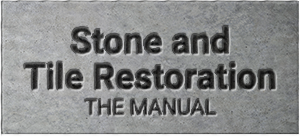Beyond Iron: The Colorful World of Stone Tile Discoloration
Stone Discoloration Occurs for Multiple Reasons
Frederick M Hueston | StoneForensics.com
Today, let’s chat about something that’s both intriguing and a bit of a headache for both stone restoration contractors and owners of marble and stone tiles – discoloration. You might be familiar with the usual suspect, iron, but guess what? There’s a whole gang of minerals out there that can change the complexion of stone surfaces. Let’s dive into this colorful world!
Manganese: The Shy Artist
First up is manganese. This little-known mineral can be quite the artist, painting your stone tiles in shades of brown or pink. It’s kind of like that quiet person at a party who suddenly reveals a hidden talent. You might not have noticed manganese before, but once it starts reacting with oxygen (oh, that chemical drama!), it begins leaving its signature on your stones.
Copper: The Green Graffiti Artist
Then there’s copper. Think of it as the graffiti artist of the mineral world. It loves to leave its mark in green or blue hues. Copper’s presence in stone is like a secret message that only reveals itself under certain conditions, like when water gets involved. It’s fascinating, but if you’re aiming for a pristine white marble, it’s more of a party crasher.
Chromium: The Subtle Green Painter
Chromium might not be a household name, but in the world of stone discoloration, it’s a notable character. Known for introducing subtle green tints, chromium can be quite the surprise element in your marble or tiles. It’s like that pinch of an unusual spice in a dish that makes you go, “Hmm, what’s that?”
Nickel: The Soft Artist in the Shadows
Nickel is another unsung hero (or villain, depending on your perspective) in the world of stone colors. This mineral can produce soft green and blue hues, often so gentle that you might miss them at first glance. It’s like a whisper in a room full of loud conversations – easy to overlook, but intriguing once noticed.
Sulfur: The Yellowish Mischief-Maker
Sulfur can bring a yellowish tinge to your stone tiles, like a splash of sunshine that overstays its welcome. Often associated with a ‘rotten egg’ smell in other contexts, in the world of stone, it’s all about color. Sulfur stains can be particularly stubborn, so if you see a hint of yellow, sulfur might be the secret artist.
Pyrite: The Fool’s Gold Trickster
Pyrite, also known as fool’s gold, can be a real trickster when it comes to stone tiles. When exposed to air and moisture, pyrite can oxidize and cause brownish or gold-like stains. It’s like that friend who always has a surprise up their sleeve – never quite what you expect.
Organic Interlopers: The Uninvited Guests
Moving on, we’ve got organic materials. These are your leaves, bits of wood, and other natural elements that somehow find their way into the stone. They’re like the uninvited guests at a garden party who leave their mark – quite literally. As they decompose, they can leave dark, shadowy stains that are quite stubborn.
The Chemistry Behind the Canvas
So, how do all these minerals create their art on your stone tiles? It’s all about chemistry. When these minerals are exposed to water, air, and other environmental elements, they undergo chemical reactions. Think of it as their way of interacting with the world. And just like in any social interaction, they leave an impression – in this case, a colorful stain.
Playing Detective and Doctor
Now, if you’re dealing with this kind of discoloration, don’t worry, you’re not alone. There are ways to figure out which mineral is the culprit and how to address it. Sometimes it’s like playing detective, other times more like being a doctor treating a patient. From poultices that draw out the stain to professional cleaning methods, there are solutions.
In the world of natural stone tiles, discoloration is part of the journey. It’s about understanding these minerals, their interactions, and how we can coexist with them. So, next time you spot a stain on your stone tile, remember, it’s not just a blemish – it’s a story and a science lesson all rolled into one!
And that’s the colorful tale of minerals in stone tiles, beyond our well-known friend iron. Stay curious and keep loving those beautiful, albeit sometimes unpredictable, stone surfaces!


